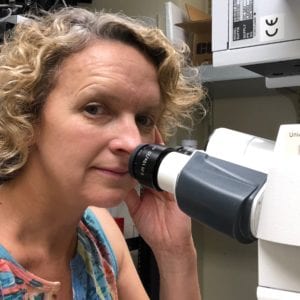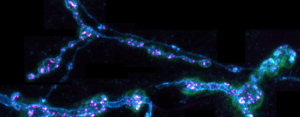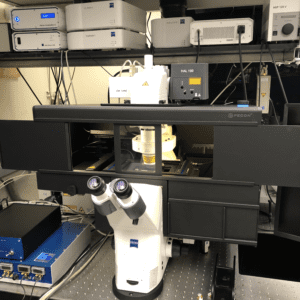Holly Aaron, director of the Molecular Imaging Center, discusses the role of core facilities on campus and in science at large.
Most people have an image in their mind of what a research lab might look like: the principal investigator in their office, and their hardworking team of graduate students and postdocs pulling long hours in the lab, performing all kinds of experiments. What many don’t consider is what those researchers do when they need to conduct an experiment using equipment that their lab doesn’t own. Who do they turn to then?
Enter the core facility. “Core research facilities are like a lending library for a certain set of tools,” explains Holly Aaron, director of the CRL Molecular Imaging Center (MIC) “Except we don’t lend the instruments out; we allow scientist to come into the facility to use them.”

Core facilities lend access to many varieties of tools and instruments, from microscopes to lasers to mass spectrometers. The MIC is one of 32 core facilities on the Berkeley campus, and one of nine focused on imaging. QB3-Berkeley is home to 11 of these campus core facilities, including the QB3 Cell and Tissue Analysis Facility and the High-Throughput Screening Facility, which provides services to aid users in growing and assessing mammalian cells, as well as instrumentation to allow users to screen large numbers of these cells at a time, something an individual lab may not have the capability to do. The QB3 core facilities go beyond work in mammalian cells though, and also include resources like the QB3/Chemistry Mass Spectrometry Facility, which allows for the analysis of chemical compounds, both smaller molecules made in a lab and large, complex molecules made by biological organisms.
The MIC houses around 20 microscopes and serves over 400 individual users from more than 90 labs on campus. Some might wonder, though, why so many people don’t have their own microscopes, and why they would possibly need to use one from a shared resource like a core facility. While many of these labs probably have their own simple light microscope—think the kind you’ve probably seen on any TV show with a forensics lab, or the one represented by the “microscope” emoji—very few are going to have the specialized and expensive instruments that the MIC is able to purchase, house, and maintain.
“These aren’t your sixth grade microscopes,” Aaron points out, “these are million dollar microscopes that can do techniques and experiments that regular microscopes can’t typically do.”
This is the case for many core facilities, and the services and instrumentation they provide to scientists. A researcher comes up with an experiment they want to do but finds they don’t have the right equipment, or maybe it’s a special technique that they don’t know how to do. Core facilities are there to provide access to instrumentation and the training needed to use them properly, or in some cases for the facility staff to run the experiments themselves as a service. And while some labs may have the funding to purchase new equipment, many instruments critical for certain types of work are prohibitively expensive for an individual lab to acquire.
However, a shared facility may be able to justify the expense and apply for a grant just for that particular instrument. “Not everyone can have a cyclotron,” Aaron points out, to give an extreme example. An individual lab can’t have a cyclotron, a type of particle accelerator used in nuclear physics experiments (and that garnered Ernest Lawrence of Berkeley his Nobel Prize in 1939), but it can exist in a national shared facility, and people can reserve time and come to use it— a core facility on a grand scale. Single labs don’t have the ability to manage the “cost, space, and expertise,” as Aaron summarizes it. “And that’s what the cores provide.”
The impact of core facilities on the research conducted at UC Berkeley isn’t limited to the microscopes themselves, however. With so many users from so many different labs, running a core facility like the MIC is just as much a “people job” as it is a “science job.” In a typical year, according to Aaron, the MIC staff trains 100 to 120 new users.

In addition to training new users and managing existing ones, a lot of what the MIC does for researchers is making connections. “We do a lot of referrals,” Aaron says, elaborating that “part of my position is just knowing what else is available on campus and pointing students and postdocs in the right direction, and to the right people, which can sometimes be challenging since it’s such a big campus.”
Sometimes these connections lead to interesting collaborations among researchers and different core facilities, such as when the MIC did some imaging for the art department of smartphone screens, in collaboration with the Electron Microscope Laboratory. Labs that develop a new technique or tool might also make their discoveries available to other scientists through the help of a core facility. For instance, the Cas9 protein, made famous by Nobel Laureate Jennifer Doudna, can be acquired and used by other labs for their own experiments through the QB3 MacroLab. More often, however, these connections are about helping scientists to find the best instruments and resources for their work.
In the case of microscopy, for example, researchers may not know which of the imaging-focused core facilities best suit their needs. This is where the core facility staff can guide a lost graduate student to the right microscope for the job. Core facility staff will talk with new users about what they’re trying to do, and work with them on the kinds of experiments they want to do, and then point them towards whichever core will best suit their needs.

“We ask them about their work to find out what they want to do, then find out what they really want to do, and help them figure out how to do it, and with what instrument,” says Aaron, in summary. The expertise of the core facility staff comes into play in narrowing down the exact types of experiments that will be most helpful for the users and labs that depend on the MIC and other cores on campus.
Expertise in instrumentation or techniques an individual lab may not have, and the ability to make connections across campus or even beyond. These are what core facilities offer to researchers at UC Berkeley and elsewhere, bringing scientists from many disciplines together and facilitating their work.
“The impact we can have, it’s about connecting the dots across campus,” Aaron says. “It’s about saying, ‘this researcher needs these three things,’ but it’s also about being open and accessible and welcoming, because people may have never used a microscope before,” emphasizing again that the work in a core facility is as much about the people as it is about the science.
“I think it’s exciting to be in a core facility,” Aaron says, “especially one that reaches across different sciences. I’m seeing new things every day and learning new things.” Core facilities of all stripes reach across fields, and make connections— between labs, between researchers and instruments, between confused grad students and experts who can help them— facilitating cutting edge science.